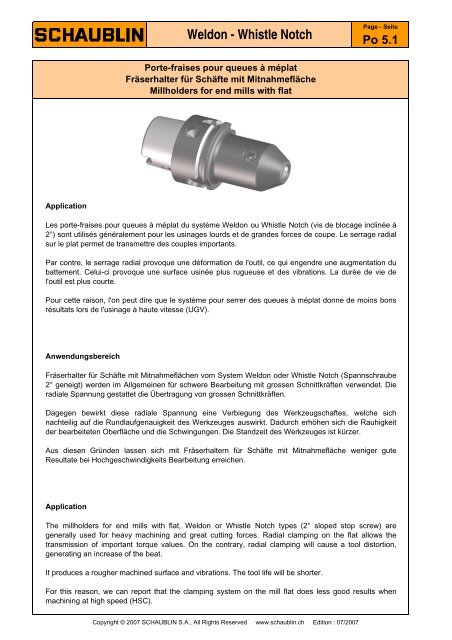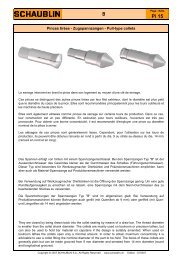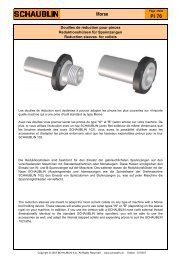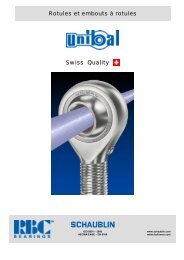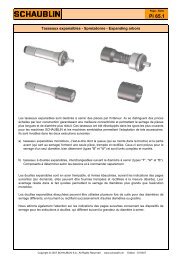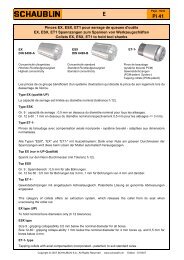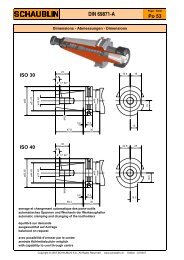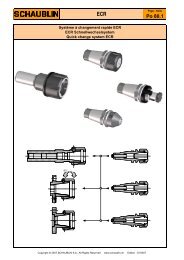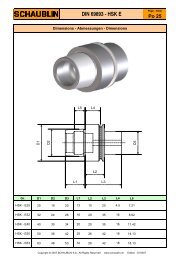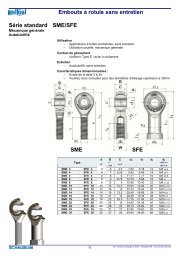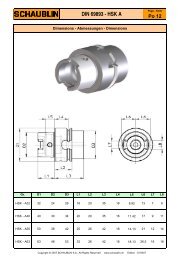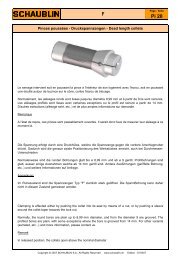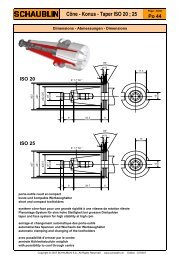Frettage - Schrumpfen - Shrinking - Schaublin SA
Frettage - Schrumpfen - Shrinking - Schaublin SA
Frettage - Schrumpfen - Shrinking - Schaublin SA
Create successful ePaper yourself
Turn your PDF publications into a flip-book with our unique Google optimized e-Paper software.
Application<br />
Weldon - Whistle Notch<br />
Porte-fraises pour queues à méplat<br />
Fräserhalter für Schäfte mit Mitnahmefläche<br />
Millholders for end mills with flat<br />
Page - Seite<br />
Po 5.1<br />
Les porte-fraises pour queues à méplat du système Weldon ou Whistle Notch (vis de blocage inclinée à<br />
2°) sont utilisés généralement pour les usinages lourds et de grandes forces de coupe. Le serrage radial<br />
sur le plat permet de transmettre des couples importants.<br />
Par contre, le serrage radial provoque une déformation de l'outil, ce qui engendre une augmentation du<br />
battement. Celui-ci provoque une surface usinée plus rugueuse et des vibrations. La durée de vie de<br />
l'outil est plus courte.<br />
Pour cette raison, l'on peut dire que le système pour serrer des queues à méplat donne de moins bons<br />
résultats lors de l'usinage à haute vitesse (UGV).<br />
Anwendungsbereich<br />
Fräserhalter für Schäfte mit Mitnahmeflächen vom System Weldon oder Whistle Notch (Spannschraube<br />
2° geneigt) werden im Allgemeinen für schwere Bearbeitung mit grossen Schnittkräften verwendet. Die<br />
radiale Spannung gestattet die Übertragung von grossen Schnittkräften.<br />
Dagegen bewirkt diese radiale Spannung eine Verbiegung des Werkzeugschaftes, welche sich<br />
nachteilig auf die Rundlaufgenauigkeit des Werkzeuges auswirkt. Dadurch erhöhen sich die Rauhigkeit<br />
der bearbeiteten Oberfläche und die Schwingungen. Die Standzeit des Werkzeuges ist kürzer.<br />
Aus diesen Gründen lassen sich mit Fräserhaltern für Schäfte mit Mitnahmefläche weniger gute<br />
Resultate bei Hochgeschwindigkeits Bearbeitung erreichen.<br />
Application<br />
The millholders for end mills with flat, Weldon or Whistle Notch types (2° sloped stop screw) are<br />
generally used for heavy machining and great cutting forces. Radial clamping on the flat allows the<br />
transmission of important torque values. On the contrary, radial clamping will cause a tool distortion,<br />
generating an increase of the beat.<br />
It produces a rougher machined surface and vibrations. The tool life will be shorter.<br />
For this reason, we can report that the clamping system on the mill flat does less good results when<br />
machining at high speed (HSC).<br />
Copyright © 2007 SCHAUBLIN S.A., All Rights Reserved www.schaublin.ch Edition : 07/2007


